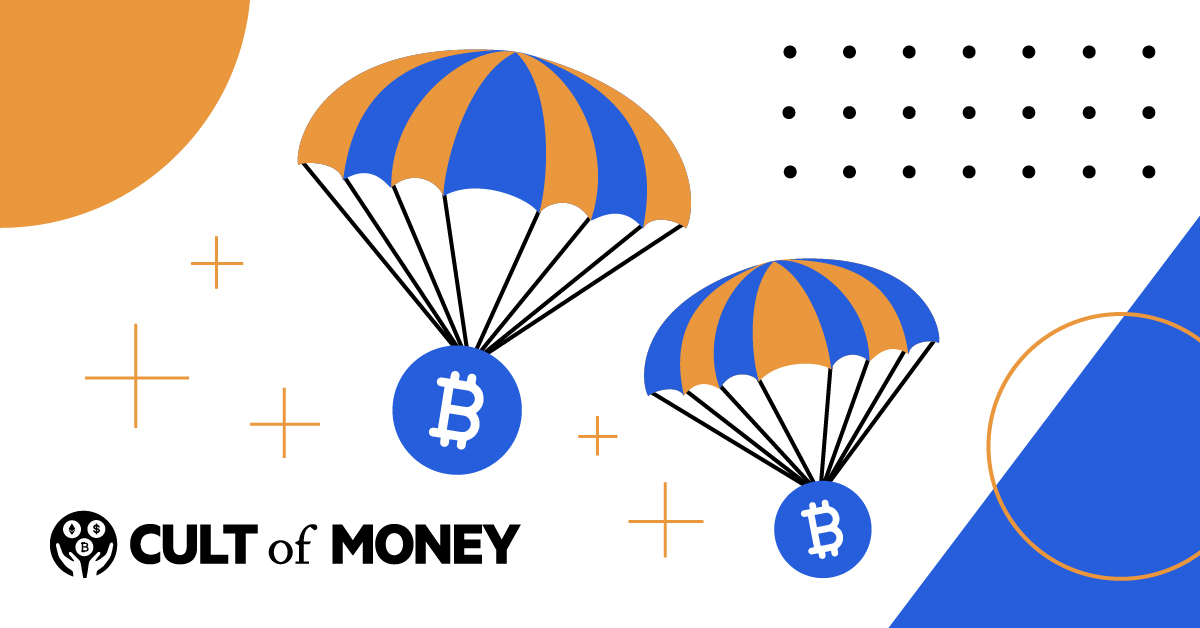
If a company told you it’s giving you free cryptocurrency, no strings attached, you might think it’s too good to be true.
However, cryptocurrency airdrops are exactly that: an opportunity to get some free tokens just for showing an active interest in a new cryptocurrency project.
Airdrops have been incredibly popular over the last few years with crypto’s boom. But how do crypto airdrops work? And, more importantly, can crypto investors actually make meaningful returns by participating in airdrops? Here's what you need to know.
What Is A Crypto Token Airdrop?
A crypto airdrop involves distributing cryptocurrency tokens or coins for free to numerous wallet addresses. Typically, cryptocurrency airdrops are done as a marketing tactic to increase public interest surrounding a new project.
Usually, crypto airdrops occur early on in a project’s development. For example, developers might mint millions of tokens for their new cryptocurrency or DeFi project and then send these coins out to users to attract more attention.
This marketing tactic is quite clever. After all, getting free tokens is advantageous for consumers who might benefit from that new crypto increasing in price. On the other hand, projects can benefit from airdrops because of increased exposure and having more stakeholders who want the project to succeed.
Different Types Of Token Airdrops
The gist of a crypto airdrop is to give free tokens to people to create excitement. However, there are several types of airdrops, each with certain requirements to actually get your free tokens.
Standard Airdrops
A standard airdrop is the most common type of airdrop and is very simple. To participate in a standard airdrop, you typically create an account with the project that’s initiating the airdrop. You also enter your wallet address to receive your free tokens. Overall, standard airdrops are similar to sign-up bonuses.
Exclusive Airdrops
Exclusive airdrops are airdrops that award loyal members of a community or project. With this type of airdrop, very early adopters of a project can get additional rewards later on in the project as a way for the developers to show their appreciation.
Some companies and influencers also host exclusive airdrops on their own. You can find many of these airdrop opportunities by following airdrop aggregators on Twitter or by following developers and individuals closely involved in various new crypto projects.
Bounty Airdrops
Bounty airdrops require completing some sort of task to participate. These airdrops take more work to participate in, but the tasks are generally simple. Examples of tasks for bounty airdrops include:
- Following the new project on social media
- Sharing news about the airdrop on social media
- Signing up for the project’s newsletter
Bounty airdrops are very common on social media, especially on platforms like Twitter where a simple retweet and comment can gain you an entry.
Holder Airdrops
A holder airdrop, also known as a "hodlr" airdrop, awards people with free tokens for holding specific types of cryptocurrency. In this sense, it’s almost like a dividend payment back to shareholders or a loyalty bonus.
Holder airdrops usually have time requirements, so you have to hold a certain type of crypto for months or even years. Airdrops.io has a comprehensive list of holder airdrops, including projects like:
- Coreum (for SOLO holders)
- Icon (for ICX holders)
- PulseChain (for ERC20 and NFT holders)
- TerraFloki (for STT and MINE holders)
- Terra World (for LUNA holders)
As you can see, these are pretty obscure projects. Some holder airdrops also reward you for holding several types of tokens or for holding specific NFTs.
Hard Fork Airdrops
A hard fork occurs when a blockchain’s protocol changes so significantly that the new blockchain version doesn’t accept old versions. When this happens, every node within the network must upgrade to the latest version. This creates a unique “fork” off of the original blockchain.
When this blockchain split occurs, users who upgrade to the new blockchain still need their old tokens. This is where hard fork airdrops come into play, essentially depositing user’s crypto from the original chain back into their wallets on the new chain.
Hard fork airdrops are different from other types of airdrops because this isn’t usually a marketing tactic. Rather, hard forks occur because of significant changes to blockchain protocols, which are usually done for improvement or bug fixing purposes.
How Do You Claim A Crypto Airdrop?
Different types of airdrops have different claiming requirements. Usually, following and engaging with the new project is enough to participate in a large upcoming airdrop.
Bounty airdrops require a bit more work but aren’t too difficult to participate in. Exclusive airdrops can have trickier rules, like having to own a certain NFT from a project. Similarly, holder airdrops sometimes have long timeframe requirements.
Examples Of Past Airdrops
There are thousands of cryptocurrencies out there aside from Bitcoin and Ethereum. Plus, more cryptocurrencies are created every day. Because of this scale, it’s no surprise that there have been plenty of airdrops in recent years.
Most airdrops are for small projects that don’t really go anywhere. However, there have been more successful airdrops in the past, including:
- Stellar’s airdrop which gave away 2 billion XLM (now worth about $500 million)
- BitTorrent’s 16-part Tron airdrop
- Minereum’s 2016 airdrop which gave out over 32,000 MNE to recipients (which was worth over $400,000 at peak MNE price)
As for upcoming airdrops, getting in on the action largely requires following upcoming projects and waiting for airdrops announcements.
Are Crypto Airdrops Safe?
Crypto airdrops are safe on paper because you’re just getting free tokens in exchange for following a project. However, there are plenty of crypto scams and red flags investors should watch out for.
For starters, airdrops can often be the start of a pump-and-dump scheme in which developers try to create excitement around a project just to increase token price before selling. If an airdrop is for a project with no particular project roadmap or goal, this is a massive red flag.
Similarly, airdrops and new crypto projects can be outright scams if they pump prices and then prevent users from selling their tokens. A notable example of this was the Squid Game token scam. This token was based on the popular Netflix show Squid Game but was nothing more than a rug pull where most people were left holding the bag.
Finally, some crypto airdrops are actually done as dusting attacks. A dusting attack involves sending trace amounts of tokens to thousands of wallet addresses. Dusting attacks try to track various wallet addresses in an effort to de-anonymize them. By de-anonymizing wallet addresses, hackers and criminals can try to steal crypto from wealthy individuals through phishing scams, hacks, and even extortion.
Ultimately, you should be wary if a random amount of an obscure crypto suddenly appears in your wallet one day. It’s also important to note that most airdrops are for projects that don’t go anywhere and therefore have almost no value.
Pros & Cons
Cryptocurrency airdrops generate a lot of hype, especially when thousands of people are Tweeting about a certain airdrop just to get more tokens.
But despite the excitement, airdrops aren’t a ticket to quick cash. Here are the pros and cons of crypto airdrops you should consider before joining one:
Overall, joining airdrops makes sense if a project you believe in issues an airdrop. But if you’re trying to strike it rich by joining crypto airdrops, you’re likely wasting your time.
Alternatives To Token Airdrops
Crypto airdrops are appealing because you get free tokens. But there are other ways to score free crypto. And, some of these methods let you earn more popular coins like Bitcoin, Ethereum, Solana, and other leading cryptos.
For starters, many cryptocurrency exchanges pay welcome bonuses for signing up. Exchanges like Coinbase even have an education section where you earn small amounts of free tokens for completing educational modules for different projects.
I’ve earned around $30 in free crypto from Coinbase Earn and this took roughly five minutes of work.
Other options to generate extra crypto include staking and crypto savings accounts. For example, you can earn interest on dozens of different cryptos if you deposit them with companies like BlockFi or Celsius. Many cryptocurrencies pay 10% APY or more and you’re not relying on no-name tokens to strike it big to generate returns.
Frequently Asked Questions
Here are some of the questions that people ask most often about token airdrops:
Why do crypto airdrops happen?
Crypto airdrops usually happen to help market new projects. Airdrops can also occur after a hard fork, but for the most part, airdrops are a marketing ploy to create excitement for a new blockchain project.
Are token airdrops worth it?
Most crypto airdrops aren’t worth it since most projects don’t go anywhere. Additionally, some airdrops are downright scams. The bottom line is that airdrops are only worth it if it’s for a project you understand and trust.
Are crypto airdrops taxable?
According to the IRS, airdrops are a type of income so you have to report it on your tax return. This is another downside to participating in numerous airdrops since you might create extra red tape to deal with when filing taxes for almost no monetary gain.
If you’re serious about airdrops, using various cryptocurrency tax software like TaxBit or ZenLedger is a smart move. Crypto tax software consolidates all your transactions and can automatically tag airdrops as additional income to help you with filing.
Where can I find a legit token airdrop?
There are various sites that follow and announce upcoming airdrops that are legit, but a few of the most popular include Airdrops.io, Airdrop Alert, and CoinMarketCap.
Final Thoughts
So, are crypto token airdrops worth it? Well, the answer largely depends on what type of cryptocurrency investor you are.
Legitimate projects have and will issue airdrops that are lucrative for stakeholders. But many airdrops are practically worthless and some are outright scams that present risks for investors.
Your best bet is to only participate in airdrops for projects you understand. This means reading a project’s whitepaper, following its development roadmap, and learning as much as you can about the team behind the scenes.
Worthwhile airdrops might be few and far between. But for diligent investors, they're an exciting and fun way to benefit from digital assets.

Tom Blake is a personal finance writer with a passion for making money online, cryptocurrency and NFTs, investing, and the gig economy.
